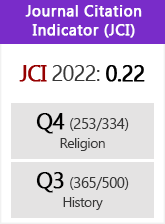Tradition and intertextuality in the Eastern Christian apocalypsis: the motf of the Kings of Ethiopia and Nubia in the (Arabic) apocalypse pf Ps.-Athanasius and its testimonia apocalyptica
DOI:
https://doi.org/10.3989/alqantara.2011.v32.i1.255Keywords:
Christian Arabic Literature, Apocayptics, Intertextuality, Literary testimoniaAbstract
The present article deals with the motif of “the kings of Ethiopia and Nubia” in one of the textual families of the Arabic Apocalypse of Ps.-Athanasius. Through the analysis of the features which constitute this motif, our aim is to show how the authors of the Apocalyptic texts worked on the basis of a material which to a large extent was standardized. This material, which we label as testimonia, was used by these authors according to various circumstances. The task expressed throughout the apocalyptic texts was created and developed in the heart of a textual and literary tradition in which intertextuality acted like a determining structural mechanism in the shape, modeling and survival of this literary genre throughout the centuries within the several Eastern Christian communities.
Downloads
Download data is not yet available.
Downloads
Published
2011-06-30
How to Cite
Monferrer Sala, J. P. (2011). Tradition and intertextuality in the Eastern Christian apocalypsis: the motf of the Kings of Ethiopia and Nubia in the (Arabic) apocalypse pf Ps.-Athanasius and its testimonia apocalyptica. Al-Qanṭara, 32(1), 199–228. https://doi.org/10.3989/alqantara.2011.v32.i1.255
Issue
Section
Articles
License
Copyright (c) 2011 Consejo Superior de Investigaciones Científicas (CSIC)

This work is licensed under a Creative Commons Attribution 4.0 International License.
© CSIC. Manuscripts published in both the printed and online versions of this Journal are the property of Consejo Superior de Investigaciones Científicas, and quoting this source is a requirement for any partial or full reproduction.All contents of this electronic edition, except where otherwise noted, are distributed under a “Creative Commons Attribution 4.0 International” (CC BY 4.0) License. You may read here the basic information and the legal text of the license. The indication of the CC BY 4.0 License must be expressly stated in this way when necessary.
Self-archiving in repositories, personal webpages or similar, of any version other than the published by the Editor, is not allowed.














